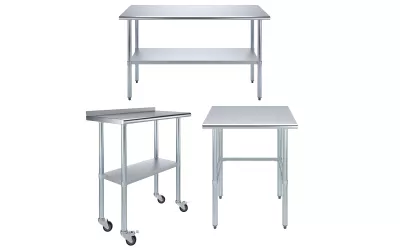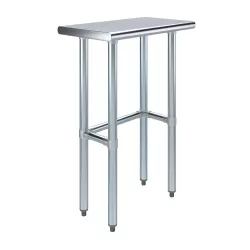- Stainless Steel Tables
- Stainless Steel Sinks
- Shelving
- Plumbing
- Accessories
- Storage & Transport
- Kitchen Equipment
Heavy-Duty Stainless Steel Work & Prep Tables for Professional Use
 Open category
Shop 198 products
Open category
Shop 198 productsOpen category
Shop 16 productsLast Reviews Stainless Steel TablesMia ThompsonJuly 29, 2025Excellent prep table with plenty of workspace. The double-tier overshelf keeps my supplies handy and organized. Sturdy and easy to clean — just what I needed.David NguyenJuly 29, 2025This long table fits perfectly along my wall and offers plenty of prep space. The two shelves underneath are sturdy and perfect for extra storage. Easy to clean and well-made.Sarah ColemanJuly 29, 2025Love the extra length — it gives me plenty of room to work. The two shelves underneath are great for storage, and the stainless steel cleans up easily. Solid build for the price.Mark PhillipsJuly 29, 2025Great size and very sturdy. The double shelves help keep my prep area organized. Easy to clean and fits perfectly in my kitchen.Carlos MendezJuly 29, 2025Super useful table for my home kitchen extension. I use the top for food prep and the two undershelves for storing trays, cutting boards, and dry goods. It’s long but not too deep, so it fits along the wall without hogging space. The steel is easy to wipe down and doesn’t scratch easily. Very happy with the sturdiness and layout.Priya DesaiJuly 29, 2025Exactly what I needed for my small catering setup. The narrow width fits perfectly in my prep area without getting in the way, and the two-tier shelf is a lifesaver for keeping spices, utensils, and containers within arm’s reach. Easy to clean, doesn’t wobble, and looks sharp in stainless steel.Jonathan ReedJuly 29, 2025This table exceeded my expectations. It’s heavy-duty without being bulky, and the maple top handles everything from sanding to hammering without a mark. The adjustable shelf is super practical — I keep my clamps and power drill there for easy access. Definitely feels like a professional-grade workbench at a fair price.Rachel KimJuly 29, 2025Great compact table for smaller spaces. I use it in my laundry room as a folding station and mini workbench, and it’s been perfect. The maple top is smooth and tough, and I love that the shelf underneath can be adjusted to fit baskets and bins. Very sturdy and well-built — no complaints at all.Marcus BennettJuly 29, 2025Solid craftsmanship and plenty of surface area. The 60-inch length gives me room to spread out my projects, and the maple top is smooth and durable. The adjustable shelf underneath is a game-changer for organizing tools and materials. Feels super stable—no wobble at all. Highly recommend for serious DIYers.Lisa TranJuly 29, 2025Perfect size for my garage workspace. The maple top feels solid and looks great, and I really like having the adjustable undershelf—it fits my toolboxes without any hassle. Assembly was simple and everything feels sturdy once set up. Definitely worth the price.Kevin BennettJune 23, 2025Plenty of storage on this table thanks to the extra shelves. Works well in my home bakery for organizing supplies and prepping dough. Sturdy and reliable — great value for a busy kitchen setup.Steven WalkerJune 23, 2025Solid construction and easy to clean. Ideal for prepping food or handling crafts. The undershelf is strong and gives me more storage than I expected. Very satisfied with the quality.Melissa CarterJune 23, 2025Perfect for my compact workspace. The extra shelves make it easy to keep everything organized. Clean, sturdy, and just what I needed for daily tasks.Bryan MatthewsJune 23, 2025This table is a powerhouse. It handles heavy equipment and bulk supplies without any wobble. The three undershelves are a big bonus for sorting everything from ingredients to tools. I recommend this for anyone who wants to streamline their workspace with something reliable and truly industrial.Heather GrahamJune 23, 2025Love how compact this table is, but still manages to provide three spacious shelves for storage. The build quality is excellent, and it’s simple to clean up after a long day. The adjustable shelves are handy for all sorts of gear. Ideal for anyone tight on space but needing extra organization.Ethan ClarkJune 23, 2025Solid build and plenty of room for all my tools and materials. The three undershelves keep everything within easy reach, and the stainless surface stands up to constant use. Assembly was straightforward and the finished table is impressively stable. Perfect for keeping my workspace organized and efficient.Lauren EvansJune 23, 2025Impressed by how much storage the three shelves provide in such a small footprint. Perfect for keeping my supplies organized, and the table feels sturdy even when loaded up. Cleans up fast and the instructions made assembly easy. Great find for anyone needing extra workspace and storage together.Peter HarrisonJune 23, 2025This table has completely changed my workspace setup. The surface holds up to heavy equipment and still looks great after plenty of use. The shelf underneath is a game changer for keeping tools and supplies off the main table. Easy to clean, incredibly sturdy, and feels built to last for years. Assembly was clear and straightforward.Megan DawsonJune 23, 2025Really impressed with the durability and look of this table. The shelf underneath gives me extra storage for kitchen gadgets and the whole setup feels solid. Wipes clean easily and doesn’t take up much room. Assembly was quick and painless. Just what I needed for my busy kitchen.Ryan CooperJune 23, 2025Fits perfectly in my laundry area for folding clothes and storing baskets underneath. The surface is solid and easy to wipe clean. Quick assembly and takes up hardly any space, but still strong enough for heavy loads. Good value for the quality.Show MoreAs a leading US manufacturer and distributor of commercial stainless steel equipment AmGood Supply delivers heavy-duty stainless steel work tables and prep tables directly to your business. Designed for reliability in commercial kitchens, labs, and industrial settings, our extensive selection is built with durability and fast, free shipping in mind.
Why Choose a Stainless Steel Table
Stainless steel tables are ideal for various professional environments. It looks modern and elegant. Moreover, it works better than any other table type. It is built to support big loads and its surfaces are easy to maintain, making it a great addition to any workstation.
The main benefits are:
- Durability: Made to last for years of severe usage without breaking or bending.
- Hygiene: The non-porous surface prevents germs from growing, making it great for use in labs or for manufacturing food.
- Corrosion resistance: The strength and look of the material don't alter when it comes into contact with water or chemicals.
- Low maintenance: It needs a quick cleaning to keep it good-looking and germ-free.
- These features make a stainless steel work table not only a useful tool, but also a long-lasting answer for busy activities.
Types of Stainless Steel Work Tables
Tables with Flat Tops
A traditional style with a level work surface that doesn't break. Good for regular food processing, packaging, or putting things together. Because they are basic, they may be used in almost any field.
Tables with Shelves Underneath
Such a style has more storage space under the main surface. Great for keeping tools, materials, or equipment within reach, which makes work flow better.
These features include sturdy wheels that make it simple to transfer from one work location to another. They feature brakes that keep them stable while they're not moving, making them great for busy work areas.
Tables with the Backsplash or Cabinets
A stainless steel table with a backsplash keeps spills from getting on the wall, and cabinet types keep things tidy and orderly by keeping them out of sight.
Selecting the Right Commercial Stainless Steel Table
Finding the ideal stainless steel table requires understanding material specifics. Most AmGood work surfaces use T-430 stainless steel, and we offer options up to 18-gauge construction for enhanced durability. We manufacture tables certified for use in commercial kitchens, When choosing a stainless steel table, consider these key factors:
Material Grade (304 vs. 430): We use different grades of stainless steel to match your needs. Grade 304 offers superior corrosion resistance and is ideal for humid or chemical-heavy environments, while Grade 430 is a durable, cost-effective option for general use.
Gauge (Thickness): The gauge number indicates the thickness of the steel. A lower gauge (e.g., 14-gauge) means thicker, more durable steel, while a higher gauge (e.g., 18-gauge) is more suited for lighter-duty tasks.
Load Capacity & Size: Consider the amount of weight your table will support and measure your available floor space to ensure a perfect fit.
Fixed vs. Mobile: Choose a fixed table for stability in permanent locations or a mobile unit for the flexibility to adapt to various room layouts and functions.
Our stainless steel tables are trusted by professionals in various industries, including:
- Commercial kitchens & food processing
- Bars and restaurants
- Repair shops & workshops
A stainless steel work table is more than just a piece of furniture; it’s a critical component for a productive, clean, and organized workspace. By choosing the right type and features for your specific needs, you are investing in a space that is both efficient and durable.
All AmGood tables are backed by our promise of Unlimited Fast & Free shipping. Find the perfect size and configuration for your restaurant, workshop, or residential space today. Got questions? Call us today!
ShareSign up to Newsletter... Register now to get updates on promotions & coupon. - Stainless Steel Sinks

